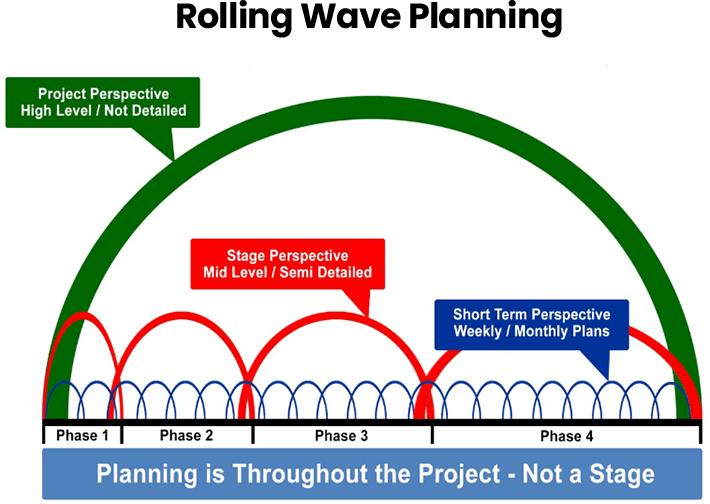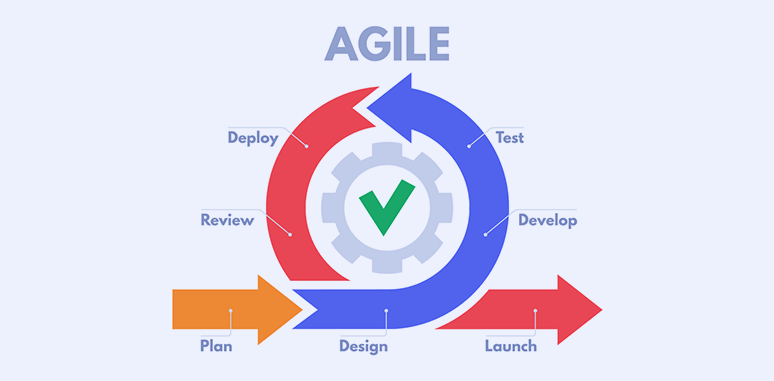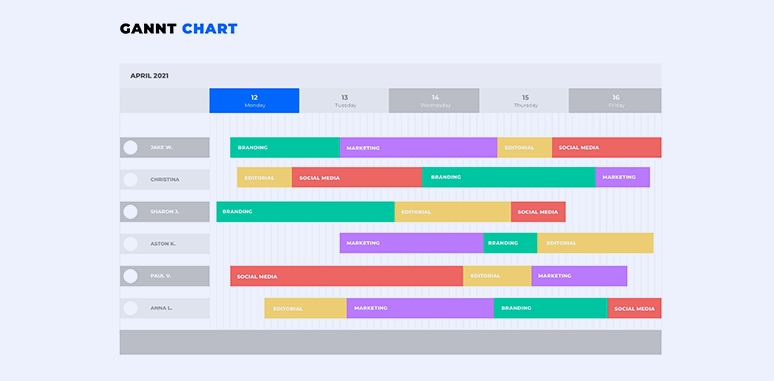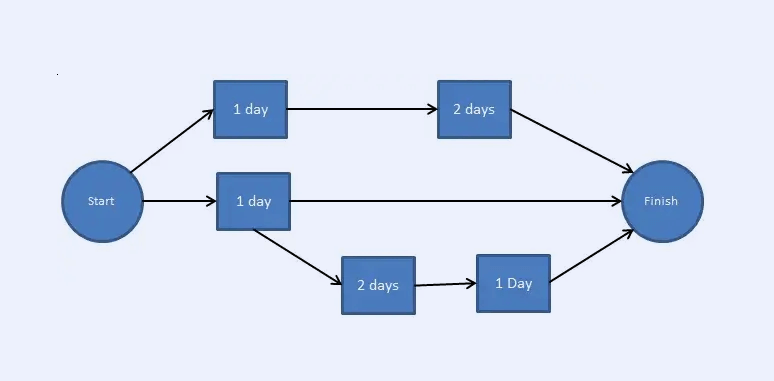
Click the button to start reading
Learning to Roll with It: Wave Planning in Project Management
Do you ever decide to take a trip, and suddenly find yourself thinking through every detail, right down to where you’re going to eat meals and what toiletries to pack in your suitcase?
It’s easy to get ahead of ourselves sometimes.
As the Birds sang in their #1 Hit back in 1965, “to everything there is a season.” There’s a time to make broad sweeping generalized plans, and a time to get down into the nitty-gritty.
As a project manager, you probably dread giving vague, evasive answers to clients when they ask about timelines and deliverables. It makes you sound mushy and unreliable. You want to be on top of your game, rather, and promise the client certainty around delivery dates and milestones.
The funny thing about projects, however, is that over-planning can actually lead to mediocre outcomes.
Learning to be open to uncertainty, and to answer questions with the phrase “I don’t know yet” is key to reducing risk and improving outcomes in project management.
In fact, project management even has systems developed around this idea. One is known as rolling wave planning. Want to learn more about it and how to apply to your projects? Then stay tuned, cause that’s what we’re covering in this post.

Rolling Wave Planning Defined
Rolling wave planning entails approaching a project in successive stages, from larger to smaller time frames. With each graduation, the planning becomes increasingly detailed and specified.
Here is the definition from the Project Management Body of Knowledge Guide, Sixth Edition:
“Rolling wave planning is an iterative planning technique in which the work to be accomplished in the near term is planned in detail, while work further in the future is planned at a higher level.”
Let’s look at what this definition looks like in real life.
Step 1: The Big Picture
Imagine you’re assigned a big project that’s slated to last 18 months or more. The key information you have at this point is the project objective, timeline and budget.
Before the project begins, your task is to assess the entire project with a broad overview. You may have notes from a similar project from the past to assist in creating benchmarks around project stages and their duration.
The objective, essentially, is to create a big-picture sketch.
Step 2: The Stage Planning
During the project, as each stage comes onto the horizon, it’s possible to plan out the details with greater specificity.
This more scrutinized planning may well cause adjustments to things like the timeline, deliverables, and the budget.
Step 3: The Nitty-Gritty
After it’s been determined what’s to be accomplished during one stage of a project, it’s then possible to map things out in even greater detail.
Let’s say one stage is forecasted to last three weeks. As each week approaches, the project manager can create a work breakdown structure to plot the sequence of all the tasks for that week.
Depending on the nature of the work, you may want to break work down even further into daily work plans.

As you can see, with rolling wave planning you don’t create one master plan, then dust off your hands and be done with it. Planning happens throughout. The plan is consistently re-evaluated and updated. These various stages of planning look like a series of rolling waves.
It’s very difficult to plan anything three years in advance. Breaking it down into successively smaller bite sized chunks, and looking just one month out is much easier.
Sometimes the planning levels are referred to as Schedule Levels 1, 2 and 3. You may even have a Schedule Level 4 or 5 if this level of detail makes sense for the project.
This form of planning is very similar to agile, and it’s popular in construction projects, and any project really that requires continual changes and adjustments.

Examples of Rolling Wave Planning
We use rolling wave planning in our lives all the time. At some level, it’s intuitive. Let’s look at three scenarios we might encounter in our lives, and consider the certainties and uncertainties for each of them.
A Short-Term Plan
Let’s say you’re planning a weekend bonfire at your home, and it’s just a few days out.
Certainties: The date, the time, the location, the decorations, and a list of people who plan to come.
Uncertainties: The food each person plans to bring, and the music you’ll play at the party.
A Mid-term Plan
Now, let’s say you have a weekend ski trip planned for the upcoming month.
Certainties: The dates, the ski resort and the place you plan to stay.
Uncertainties: The items in your suitcase and the restaurants you’ll dine at for meals.
A Long-Term Plan
Finally, let’s consider a vacation you have planned six months from now.
Certainties: The location of the vacation spot.
Uncertainties: The duration of the trip, the mode of travel (plane or car), the accommodations, the people who are coming on the vacation with you.
As you can see, rolling wave planning is about looking more closely at a plan as things come into view. With each smaller time frame, the plans become more and more specific.

The Benefits of Rolling Wave Planning
Why do project managers utilize rolling wave planning?
One way to appreciate the benefits of this method is to imagine the alternative.
Take a family vacation that’s eight months out. What if you purchased plane tickets, reserved a hotel room, and packed your suitcase with all of your favorite clothes when the vacation is still a half year away?
It’s not difficult to see that this planning could lead to a headache later on. Your work schedule could change during the upcoming months, forcing you to adjust the dates. And you certainly will find yourself digging into your suitcase for some of your favorite t-shirts and jeans.
All of the initial planning was wasted energy.
This silly example demonstrates that many details simply cannot be determined at the start. If you have an 18-month project, it’s tempting to feign certainty and plot everything out on a gantt chart. But from that far out, granular planning is worthless, as so much is certain to change.
Now, let’s look at three clear benefits of rolling wave planning
Saves Time (No Rework)
If you adopt a “we’ll cross that bridge when we come to it” mantra to project planning, then you do the planning when it’s going to be effective and certain. You can even pull out a gantt chart at this point and it should be reliable.
Whereas if you plan things from too far out, you still don’t know enough about how things are going to roll out to determine the small details.
Reduces Risk
Rolling wave planning increases uncertainty. For example, a project manager using this system openly acknowledges that he or she doesn’t know the details of stage 3 during the middle of stage 1.
However, it reduces risk. A simple definition of risk is that it’s uncertainties that matter. A risk management plan looks at the probability of these uncertainties.
When planning takes place around the actual time these risks might surface, it’s much easier to identify all of the threats and vulnerabilities posed to certain assets, and then put a solid plan in place to either mitigate, avoid, transfer or accept them.
Take a construction project, for example. Inclement weather always poses some level of risk. However, you have no idea of weather patterns at the beginning of an 18-month project. You could find yourself taking all sorts of precautions against something that never happens. Rolling wave planning waits to plan for this risk within a 1-2 week time frame.
Allows for Change
One of the greatest benefits of rolling wave planning is that it allows for changes to occur during a project. Sometimes it’s impossible to know at the onset what a final deliverable may look like, even with a clear set of requirements. Developments during the project, new knowledge and the manifestation of risks serve to alter the final outcome.
When a project manager waits for these bends and curves and is poised to adapt and pivot, it ultimately serves to create a deliverable that solves the client’s problem or meets their needs.
As you can see, rolling wave planning benefits a project in several key ways.
However, the nature of a project determines the level of uncertainty it’s able to assume.
Some projects can have a lot of uncertainty at the beginning, as changes and pivots may not pose a huge risk. However, other projects must lay out clear definite plans at the beginning, as the cost to make changes would be enormous. And so the degree to which a project manager adapts rolling wave planning into a project depends on the nature of the project.

Tools and Methods for Using Rolling Wave Planning
Rolling wave planning means bringing people together at key pivotal moments and creating space to look at all aspects of a project, including risks, issues, constraints, the scope, and any upcoming decisions to make.
Successfully incorporating this method into a project requires a few tools and strategies.

Scrum Ceremonies
The agile method known as scrum has several ceremonies that help to utilize rolling wave planning. They can be adopted by any team.
The first is a sprint planning session. During this session, a team looks at the next small stage (Schedule 3 level), and plots out a specific amount of work for the team to accomplish.
Another is a retrospective. This takes place at the end of a sprint. At a retrospective, the team reflects on the sprint and how everyone worked together, and identifies any improvements to make for the next go-around.
Finally, a daily scrum meeting allows the team to air concerns, identify any significant changes or risks as they surface.
Taken together, these three processes create a system of communication that allows for the on-going planning that’s integral to rolling wave planning.

Gantt Charts
Oftentimes gantt charts get a bad rap, since they’re usually ineffective in long-term planning.
However, when a team has a relatively small stage of work, somewhere between two and six weeks, a gantt chart serves to clearly break down each task, and when it’s to be completed alongside the other tasks.
In the short-term, a gantt chart makes it easy to identify when it’s time to do things like order supplies and recruit staff.

Network Diagrams
A network diagram is another effective way to visually lay out the workflow during a project stage. It quickly identifies potential bottlenecks, and clarifies each task in its relations to other tasks.
In sum, rolling wave planning provides key benefits to a project, but it won’t “just happen.” The right tools and practices allow teams to effectively and thoroughly plan each stage of work at the right time.
Conclusion
Project managers are always pressured to present certainties to the client, upper management, and other various stakeholders.
Yet, so much about a project is uncertain. And so regardless of this pressure, it’s generally best to plan projects incrementally. Rolling wave planning means to create a large plan at the beginning, and then increasing smaller more detailed plans at each stage.
Letting things flow and being ok with some unknowns gives the project space to breathe. And ultimately, this reduces overall risk and improves the project’s output.
















